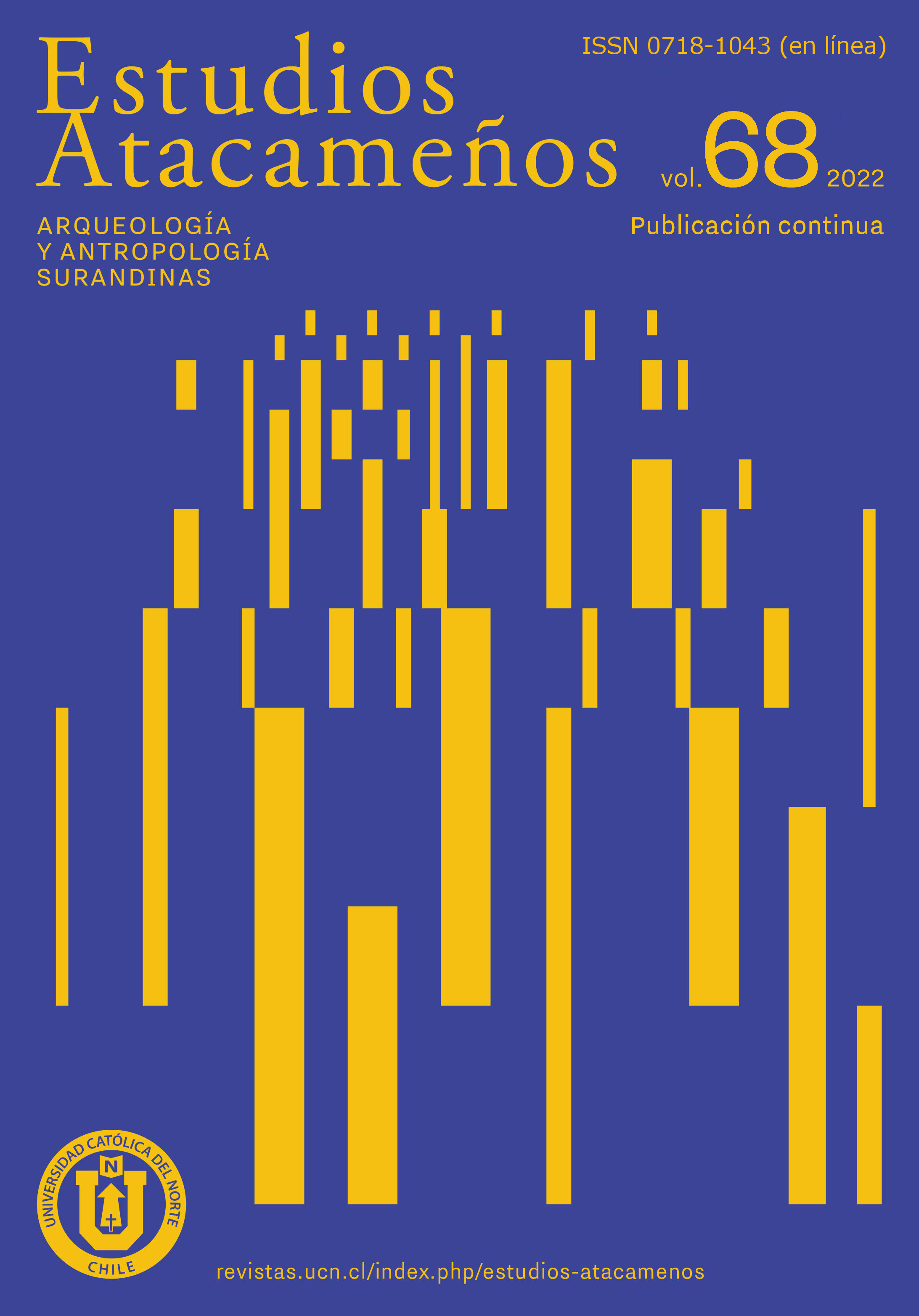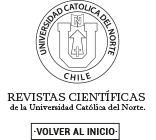Boron overexposure in pre-Columbian times
Biological and cultural implications
DOI:
https://doi.org/10.22199/issn.0718-1043-2022-0024Keywords:
Andean mummies, contamination, toxicityAbstract
In some valleys in northern Chile, the natural water reservoirs used for human consumption contain high levels of boron (> 25 mg/L). In local Pre-Colombian populations, this resulted in overexposure which is harmful to human health, causing gastrointestinal and other issues. Boron levels vary regionally, with the Lluta and Camarones Valleys presenting higher mean values (14 and 25 mg/L, respectively) than the Azapa Valley (1 mg/L). To estimate concentrations in northern Chile’s pre-Columbian populations, we used molecular absorption spectrophotometry to analyze rib samples of 211 individuals from these valleys. All the ancient rib samples presented mean boron values approximately 7 to 23 times higher than the 10.2 mg/Kg reported for modern bone tissue. Levels were highest in inhabitants of the Lluta Valley (235.52 mg/Kg) and Camarones Valley (119.09 mg/Kg), followed by those from the Azapa Valley (69.97 mg/Kg). We conclude that boron overexposure significantly impacted northern Chile’s ancient populations, and the discussions of pre-Columbian settlements and biocultural trajectories should consider water quality.
Downloads
References
Albornoz, F., Torres, A., Tapia, M. L. y Acevedo, E. (2007). Hydroponic tomato (Lycopersicon esculentum mill.) crop with desalted and deborified water in Lluta valley. Idesia (Arica), 25(2), 73-80. http://dx.doi.org/10.4067/S0718-34292007000200010
Alexander, G., Nusbaum, R. y MacDonald, N. (1951). The boron and lithium content of human bones. Journal of Biological Chemistry, 192(2), 489-496. https://doi.org/jfnj
Álvarez, L. (2014). Etnopercepción andina: valles dulces y valles salados en la vertiente occidental de los Andes. Diálogo Andino, (44), 5-14. https://doi.org/jfnh
Apata, M., Arriaza, B., Llop, E., Moraga, M. (2017). Human adaptation to arsenic in Andean populations of the Atacama Desert. American Journal of Physical Anthropology, 163(1), 192-199. https://doi.org/10.1002/ajpa.23193
Arriaza, B. (1995). Beyond death. The Chinchorro mummies of ancient Chile. Smithsonian Institution Press. https://bit.ly/3CyeFMx
Arriaza, B., Amarasiriwardena, D., Cornejo, L., Standen, V., Byrne, S., Bartkus, L. y Bandak, B. (2010). Exploring chronic arsenic poisoning in pre–Columbian Chilean mummies. Journal of Archaeological Science, 37(6), 1274-1278. https://doi.org/10.1016/j.jas.2009.12.030
Arriaza, B., Blumenstiel, D., Amarasiriwardena, D., Standen, V. y Vizcarra, A. (2020). Five thousand years of bellyaches: Exploring boron concentration in ancient populations of the Atacama Desert. American Journal of Physical Anthropology, 174(2), 254-267. https://doi.org/10.1002/ajpa.24155
Arriaza, B., Ogalde, J., Chacama, J., Standen, V., Huamán, L. y Villanueva, F. (2015). Estudio de almidones en queros de madera del norte de Chile relacionados con el consumo de chicha durante el Horizonte Inca. Estudios Atacameños, (50), 59-84. https://doi.org/jfng
Bañuelos, G. S., Ajwa, H. A., Caceres, L. y Dyer, D. (1999). Germination responses and boron accumulation in germplasm from Chile and USA grown with boron enriched water. Ecotoxicology and Environmental Safety, 43(1), 62-67. https://doi.org/dsbw8q
Bartkus, L., Amarasiriwardena, D., Arriaza, B., Bellis, D. y Yáñez, J. (2011). Exploring lead exposure in ancient Chilean mummies hair by laser ablation-inductively coupled plasma-mass spectrometry (LA-ICP-MS). Microchemical Journal, 98(2), 267-274. https://doi.org/10.1016/j.microc.2011.02.008
Barrientos, G., Sarmiento, P. y Galligani, P. (2016). Evaluación de la diagénesis ósea mediante el uso de Microscopía Electrónica de Barrido (MEB): Aproximaciones analíticas aplicables a muestras arqueológicas. Revista Argentina de Antropología Biológica, 18(2), 1-13. https://bit.ly/3SFKOXZ
Bass, W. (1987). Human osteology: A laboratory and field manual (3a ed.). Missouri Archaeological Society.
Bastías, E., González-Moro, M. B. y González-Murua, C. (2004). Zea mays L. amylacea from the Lluta Valley (Arica-Chile) tolerates salinity stress when high levels of boron are available. Plant Soil, 267, 73-84. https://doi.org/10.1007/s11104-005-4292-y
Blumenstiel, D., McDonald, M., Arriaza, B. y Amarasiriwardena, D. (2020). Exposure to geogenic lithium in ancient Andeans: unraveling Li in mummy hair using LA-ICP-MS. Journal of Archaeological Science. https://doi.org/10.1016/j.jas.2019.105062
Brito, Y. (2020). Análisis bioarqueológico de los infantes provenientes de los sitios Camarones 8 y Camarones 9 y su relación con la contaminación medioambiental [Tesis de pregrado no publicada]. Universidad de Tarapacá.
Brooks, S. y Suchey, J. (1990). Skeletal age determination based on the os pubis: A comparison of the Acsádi-Nemeskéri and Suchey-Brooks methods. Human Evolution, 5, 227-238. https://doi.org/10.1007/BF02437238
Buikstra, J. E. y Ubelaker, D. H. (1994). Standards for data collection from human skeletal Remains. Arkansas Archeological Survey.
Bundschuh, J., Litter, M., Parvez, F., Román-Ross, G., Nicolli, H., Jean, J., Liu, C., López, D., Armienta, M., Guilherme, L., Gomez, A., Cornejo, L., Cumbal, L. y Toujaguez, R. (2012). One century of arsenic exposure in Latin America: A review of history and occurrence from 14 countries. Science of the Total Environment, 429, 2–35. https://doi.org/c7c2hw
Byrne, S., Amarasiriwardena, D., Bandak, B., Bartkus, L., Kane, J., Jones, J., Yañez, J., Arriaza, B. y Cornejo, L. (2010). Were Chinchorros exposed to arsenic? Arsenic determination in Chinchorro mummies' hair by laser ablation-inductively coupled plasma-mass spectrometry. Microchemical Journal, 94(1), 28-35. https://doi.org/10.1016/j.microc.2009.08.006
Campos, H., Díaz, G. y Campos, C. (2007). Aportes sedimentarios de los ríos Lluta y San José en la zona costera de la rada de Arica, Chile. Idesia (Arica), 25(2), 37-48. http://dx.doi.org/10.4067/S0718-34292007000200005
Cöl, M. y Cöl, C. (2003). Environmental boron contamination in waters of Hisarcik area in the Kutahya Province of Turkey. Food and Chemical Toxicology, 41(10), 1417-1420. https://doi.org/10.1016/S0278-6915(03)00160-1
Cortes, S., Reynaga-Delgado, E., Sancha, A. M. y Ferreccio, C. (2011). Boron exposure assessment using drinking water and urine in the North of Chile. Science of the Total Environment, 410-411, 96-101. https://doi.org/10.1016/j.scitotenv.2011.08.073
Devirian, T. y Volpe, S. (2003). The Physiological effects of dietary boron. Critical Reviews in Food Science and Nutrition, 43(2), 219-231. https://doi.org/10.1080/10408690390826491
Díaz, A. y Bastías, E. (2014). Historia de los cultivos del maíz en un valle salado. Universidad de Tarapacá.
García, M. y Santoro, C. (2014). El maíz arqueológico como patrimonio genético y cultural del valle de Lluta. En A. Díaz y E. Bastías (Eds.), Historia de los cultivos del maíz en un valle salado norte de Chile (pp. 19-28). Universidad de Tarapacá. https://bit.ly/3EfJAyo
Hakki, S. S., Bozkurt, B. S. y Hakki, E. E. (2010). Boron regulates mineralized tissue-associated proteins in osteoblasts (MC3T3-E1). Journal of Trace Elements in Medicine and Biology, 24(4), 243-250. https://doi.org/10.1016/j.jtemb.2010.03.003
Harari, F., Roncob, A. M., Concha, G., Llanos, M., Grandér, M., Castro, F., Nermell, B. P. y Vahter, M. (2012). Early-life exposure to lithium and boron from drinking water. Reproductive Toxicology, 34(4), 552-560. https://doi.org/10.1016/j.reprotox.2012.08.009
Hogg, A., Hua, Q., Blackwell, P., Niu, M., Buck, C., Guilderson, T., Heaton, T., Palmer, J., Reimer, P., Reimer, R., Turney, C. y Zimmerman, S. (2013). SHCal13 Southern Hemisphere Calibration, 0–50,000 Years cal BP. Radiocarbon, 55(4), 1889-1903. https://doi.org/10.2458/azu_js_rc.55.16783
Horta, H. (2015). El señorío Arica y los reinos altiplánicos (1.000-1.540 d.C.). Complementariedad ecológica y multietnicidad durante los siglos pre-conquista en el norte de Chile. Quillqa.
Huanca, M., Arias, R., Cárdenas, S., Rojas, M., Sepúlveda, G., Caris, J., Caris-Maldonado, J., Bastías, E. y Maracaja-Coutinho, V. (2018). Long non-coding RNAs responsive to salt and boron stress in the hyper-arid lluteño maize from Atacama Desert. Genes (Basel), 9(3), 170. https://doi.org/10.3390/genes9030170
Hunt, C. (1993). Boron. En R. Macrae, K. Robinson y M. J. Sadler (Eds.), Encyclopedia of food science, food technology and nutrition (pp. 440-447). Academic Press.
Kakoulli, I., Prikhodko, S. V., Fischer, C., Cilluffo, M., Uribe, M., Bechtel, H. A., Fakra, S. C. y Marcus, M. A. (2014). Distribution and chemical speciation of arsenic in ancient human hair using synchrotron radiation. Analytical Chemistry, 86(1), 521-526. https://doi.org/10.1021/ac4024439
King, C. L., Arriaza, B. T., Standen, V. G., Millard, A. R., Gröcke, D. R., Halcrow, S. E. y Muñoz, I. (2018). Isotopic study of marine and terrestrial resources in the prehistory of the Atacama Desert. Chungará (Arica), 50(3), 369-396. https://doi.org/jfnm
Korpisaari, A. y Chacama, J. (Eds.). (2015). El Horizonte Medio: Nuevos Aportes para el Sur del Perú, Norte de Chile y Bolivia. Universidad de Tarapacá. https://bit.ly/3CxtIpN
Ku, W. W., Chapin, R. E., Moseman, R. F., Brink, R. E., Pierce, K. P. y Adams, K. Y. (1991). Tissue disposition of boron in male fischer rats. Toxicology and Applied Pharmacology, 111(1), 145-151. https://doi.org/10.1016/0041-008X(91)90143-3
Lovejoy, C., Meindl, R., Pryzbeck, T. y Mensforth, R. (1985). Chronological metamorphosis of the auricular surface of the ilium: A new method for the determination of adult skeletal age at death. American Journal of Physical Anthropology, 68(1), 15-28. https://doi.org/fvkkdq
Ministerio de Agricultura, Gobierno de Chile. (2009). Resultados y lecciones en reducción de boro en aguas de riego. Proyecto de innovación en XV Región de Arica y Parinacota. https://bit.ly/3rrufD9
Ministerio de Obras Públicas, República de Chile. (1994). Análisis redes de vigilancia calidad aguas terrestres. Estadística hidroquímica nacional. Etapa 1. Primera región. https://bit.ly/3RApbH9
Ministerio de Obras Públicas, República de Chile. (1997). Modelo de simulación hidrológico operacional cuenca del río San José. https://bit.ly/3EfNhUM
Ministerio de Obras Públicas, Gobierno de Chile. (2002). Estudios básicos de los recursos hídricos valles de Lluta, Azapa, Vitor y Camarones. https://bit.ly/3ydRJPM
Ministerio de Obras Públicas, Gobierno de Chile. (2016). Estudio diagnóstico de disponibilidad hídrica, Cuenca del río Camarones. https://bit.ly/3yfvj0O
Moseman, R. (1994). Chemical disposition of boron in animals and humans. Environmental Health Perspectives, 102(7), 113-117. https://doi.org/10.1289/ehp.94102s7113
Muñoz, I. (1985). Tempranos cultivos de plantas en poblaciones prehispánicas del valle de Azapa (Arica, Chile). Idesia (Arica), 9, 57-62. https://bit.ly/3rr6ds7
Muñoz, I. (1989). Perfil de la organización económico-social en la desembocadura del río Camarones: Períodos Intermedio tardío e Inca. Chungará (Arica), (22), 85-111. https://bit.ly/3V2bYKk
Muñoz, I. (2004). El período Formativo en los valles del norte de Chile y sur de Perú: Nuevas evidencias y comentarios. Chungará (Arica), 36(S.E.1), 213-225. https://doi.org/b5d8rk
Muñoz, I. (2019). Cronología del periodo Medio en el valle de Azapa, norte de Chile: Estilos, fechados y contextos culturales del poblamiento humano. Chungará (Arica), 51(4), 595-611. http://dx.doi.org/10.4067/S0717-73562019005001801
Muñoz, I. y Chacama, J. (2012). Transformación del paisaje social en Arica, norte de Chile: De pescadores arcaicos a agricultores incipientes. Estudios Atacameños, (44), 123-140. http://dx.doi.org/10.4067/S0718-10432012000200007
Nielsen, F. (1997). Boron in human and animal nutrition. Plant Soil, 193, 199-208. https://doi.org/10.1023/A:1004276311956
Núñez, L. (1982). Temprana emergencia de sedentarismo en el desierto chileno: Proyecto Caserones. Chungará (Arica), 9, 80-122. https://bit.ly/3EgDAp8
Ogalde, J.P (2019). Sobre el origen cultural del quero Cabuza. Los grupos sociales detrás de sus tecnologías de producción y uso [Tesis de doctorado no publicada]. Universidad Católica del Norte/Universidad de Tarapacá.
Organización Mundial de la Salud. (1998). The environmental health criteria. Boron. https://bit.ly/3Cy57Bc
Organización Mundial de la Salud. (2009). Boron in drinking-water: Background document for development of WHO guidelines for drinking-water quality. https://bit.ly/3Ca6Afo
Organización Mundial de la Salud. (2011). Guidelines for drinking-water quality (4a ed). https://bit.ly/2FdomlJ
Prejac, J., Skalny, A., Grabeklis, A., Uzun, S., Mimica, N. y Momčilović, B. (2018). Assessing the boron nutritional status by analyzing its cumulative frequency distribution in the hair and whole blood. Journal of Trace Elements in Medicine and Biology, 45, 50-56. https://doi.org/10.1016/j.jtemb.2017.09.018
Rivera, M. A. (2005). Arqueología del desierto de Atacama: La etapa formativa en el área de Ramaditas/Guatacondo. Universidad Bolivariana.
Rodríguez, M., Muñoz, E. y Bernal, M. (2009). Estudio comparativo de la tolerancia al boro de dos variedades de pimiento (Capsicum annuum L.). UDO Agrícola, 9(3), 509-516. https://bit.ly/3dZ95cE
Samman, S., Naghii, M. R., Lyons, P. M. y Verus, A. P. (1998). The Nutritional and metabolic effects of boron in humans and animals. Biological Trace Element Research, 66, 227−235. https://doi.org/10.1007/BF02783140
Santoro, C. (1980). Fase Azapa, transición del Arcaico al desarrollo agrario inicial en los valles bajos de Arica. Chungaá (Arica), 6, 46-56. https://bit.ly/3fI1Civ
Santoro, C., Romero Á., Standen, V. y Torres, A. (2004). Continuidad y cambio en las comunidades locales, períodos Intermedio tardío y Tardío, valles occidentales del área centro sur andina. Chungará (Arica), 36(S.E.1), 235-247. https://doi.org/c7nmwr
Scheuer, L. y Black, S. (2000). Developmental juvenile osteology. Academic Press.
Schiappacasse, V. y Niemeyer, H. (1984). Descripción y análisis interpretativo de un sitio arcaico temprano en la Quebrada de Camarones. Publicación Ocasional (41), https://bit.ly/3SzNTZF
Schillinger, B. M., Berstein, M., Goldberg, L. A. y Shalita, A. R. (1982). Boric acid poisoning. Journal of the American Academy of Dermatology, 7(5), 667-73. https://doi.org/brwj4f
Standen, V. G., Arriaza, B. T. y Santoro, C. M. (1997). External auditory exostosis in prehistoric Chilean populations: A test of the cold water hypothesis. American Journal of Physical Anthropology, 103(1), 119-129. https://doi.org/bv269t
Standen, V. G., Santoro, C. M., Arriaza, B. T. y Coleman, D. (2018). Hunting, gathering, and fishing on the coast of the Atacama Desert: Chinchorro population mobility patterns inferred from strontium isotopes. Geoarchaeology: An International Journal, 33(2), 162-176. https://doi.org/10.1002/gea.21594
Torres, A. y Acevedo, E. (2008). The salinity problem of the water and soil resources in Lluta and Azapa valleys in northern Chile. Idesia (Arica), 26(3), 3-44. https://doi.org/fw5wqf
Ubelaker, D. (1999). Human skeletal remains: Excavation, analysis, interpretation. Taraxacum.
Vielma, J. R., Picón-Borregales, D., Vergara, M. A., Carrero, P. E. y Gutiérrez-Peña, L. V. (2017). El boro, un elemento benéfico que ayuda a prevenir la osteoporosis en el humano: Una revisión de literatura. Avances en Biomedicina, 6(3), 216-226. https://bit.ly/3CwMX2I
Downloads
Published
Issue
Section
License
Copyright (c) 2022 Dr. Bernardo Arriaza, Leonardo Figueroa, Dra. Vivien Standen, Natalia Aravena, Arnoldo Vizcarra, Camila Contreras

This work is licensed under a Creative Commons Attribution 4.0 International License.

All works published in Revista Estudios Atacameños (ISSN on line:0718-1043) Revista Estudios Atacameños Creative Commons International 4.0 attribution (CC BY 4.0) licence.
Authors remain the owners of their work and may republish their articles elsewhere without having to request permission, as long as they indicate that the work was originally published in Revista Estudios Atacameños (ISSN on liine:0718-1043).












